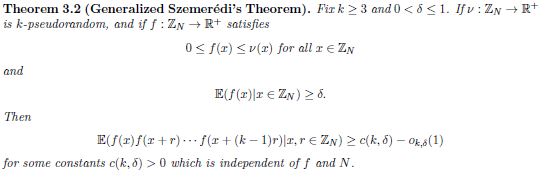| Line 16: | Line 16: | ||
'''Outline of Proof''' | '''Outline of Proof''' | ||
| − | In this outline we will consider three things: | + | In this outline we will consider three things: Szemeredi's Theorem, a generalized version of Szemeredi's Theorem with a k-pseudorandom measure, and a proposition by Goldston and Yildirim |
[[Image:szmeredi thm.jpg]] | [[Image:szmeredi thm.jpg]] | ||
| + | |||
| + | Now we consider a generalization of the above theorem below. | ||
| + | |||
| + | [[Image:szmeredi thm generalized.jpg]] | ||
| + | |||
| + | |||
Revision as of 10:36, 26 April 2014
If m, n are natural numbers, does the sequence m, m+n, m+2n, ... contain prime numbers? How many?
Elaborate on history, relation to other prime number problems, solutions.
It has long been conjectured that there are arithmetic progressions of primes of arbitrary lengths . For instance the longest known arithmetic sequence of primes is of length 26 and is given by 43142746595714191+23681770*223092870n for n = 0,1, ... ,25. Throughout history, Many mathematicians have worked for years trying to prove or disprove this conjecture, and more so to come up with a particular algorithm to find arithmetic progressions of primes of any given length. This conjecture has created many questions and problems that to this day, remain unanswered. If m, n are natural numbers, does the sequence m, m+n, m+2n, ... contain prime numbers? How many? Finite or infinite? Lengths of progressions?
History and Development
Starting as early as 1770, Lagrange and Waring questioned and researched how large the common difference of an arithmetic progression of n primes must be. In 1923, Hardy and Littlewood made a came up with a conjecture that there are infinitely prime n-tuples of the form p, p + a1, .... ,p + an for any positive integers a1, ..... ,an. This idea was then adapted to the case where a1, ... ,an is a geometric sequence in the form a1, 2*a1, 3*a1, .... ,n*a1. Ever since, there has been a plethora of questions (some answered and some not) regarding primes in arithmetic progressions.
The first theoretical development on the conjecture of arithmetic progressions of primes was given by van der Corput, who proved that there are infinitely many arithmetic progressions of primes of length 3 by using analytic methods. The more recent Green-Tao theorem generalized van der Corput's work and states the same result for any given length. However this theorem only proves the existence of such progressions, but not a method of finding them. In 2004, Benjamin Green and Terrence Tao used Szemerédi's theorem in combination with work done by mathematicians Goldston and Yildirim. Forty eight pages of dense and technical mathematics later, they had established the fundamental theorem that the prime numbers in fact do contain arithmetic progressions of length k for all k.
Outline of Proof
In this outline we will consider three things: Szemeredi's Theorem, a generalized version of Szemeredi's Theorem with a k-pseudorandom measure, and a proposition by Goldston and Yildirim
Now we consider a generalization of the above theorem below.
Test complete.



